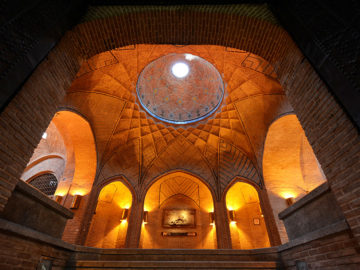Qazvin province including six counties and Qazvin city as its center has an area of about 15,567 square kilometers, ranking the 26th largest province of Iran. Qazvin is neighboring Markazi, Hamadan, Alborz, Zanjan, Gilan, and Mazandaran provinces, while Alborz mountain range surrounds the entire northern part of the province. Fars, Tat, and Azeri people, each with their own language, constitute the majority of the population in the province.

History of Qazvin dates back to the middle of the 7th B.C. century, referred to as the Median Empire’s (678-549 B.C.). The archaeological evidence obtained from the Saqz Abad hill in the Buin Zahra region, Qazvin province, shows that this area was the habitat of humans in the fourth and fifth millennia B.C. Some historical sources attribute the construction of Qazvin city to Shapur I of the Sassanid Empire (224-651 A.D.) as a strategic action to prevent the attacks of Daylamites (inhabitants of the northern regions of Iran).
Hassan Sabah, the leader of the Ismaili sect of Iran (also known as Assassins), chose the land of Alamut as their base in 1090, which was believed to be an impassable and inaccessible place and key for the gate of Gilan province in the north of the country. For two centuries, the Ismaili used the Alamut Castle as their center of governance but eventually, the castle was defeated and surrendered to the Mongol Hulagu Khan (reign: 1256-1265). During the Safavid Dynasty (1501-1736), due to the special position of this region, once again the prosperity returned to Qazvin.
The province’s breathtaking nature and sceneries attract the attention of tourists. The Ovan Lake, the ancient area of Alamut, Ismaili fortresses, and many monuments around the city of Qazvin from various periods make the attractions of the province. These monuments include the Gates of Tehran, Imamzade (shrine) Hossein, Caravanserai of Sa’d al-Saltaneh, Jame Mosque (Atiq), Aminiha Hosseiniyeh, Pavilion Mansion (Chehel Sotoun), Qajar Bath, Tomb of Hamdallah Mustawfi, and some historical water reservoirs. The local handicrafts of the province are handmade carpet, socks, fabric, cloths of the dervish, copper-mad dishes, tents, and traditional broidery.
The most common eatable souvenirs in the province include grapes (especially Takestan grapes) and various traditional sweets. The province also benefits from a diversity of cuisines such as Gheyme Nesa (rice with lamb stew), Shirin Polow (sweet rice), Siah Cheshm Polow (beans and rice), Bademjan Polow (eggplant and rice), and Kabab (Kabob). Among the prominent figures of the province are Ḥamdallāh Mustawfī (historian), Ubayd-i Zakani (poet and satirist), and Mir Emad Hassani (calligrapher).

